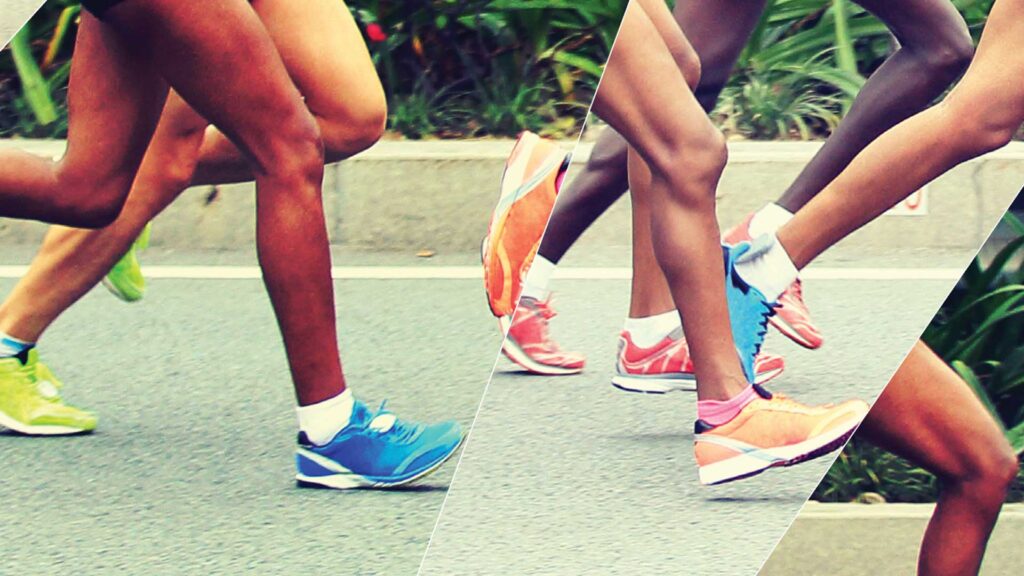When race day comes around, it’s always nice to have little things that you can do to run faster without actually having to be more fit. I think for most of us, it’s logical that if our shoes are substantially lighter, we’re going to require less oxygen to run at a given pace.
However, what doesn’t seem as clear is whether all the effort we put in to losing very small amounts of mass (like 100g) predictably improves our running economy (how efficiently we translate the oxygen we bring in into forward movement).
Taking 2lbs off our shoes will clearly be great for our running economy, but is it worth it to strip down to a flat vs. a light training shoe? And if so, how “worth it” is it?
Study
A study just published in 2016 in Medicine & Science in Sports & Exercise took an interesting look at this. In the study, 18 subjects (all sub-20 5Kers) went through three 3000m TT tests on the treadmill. The three trials included:
- Control shoes (no weight)
- 100g of weight discretely added to the shoes
- 300g of weight discretely added to the shoes
The researchers looked at oxygen consumption and TT time along with a few other things. To no surprise, the added weight caused the runners to go slower.
However, the interesting part is that there was a fairly linear decrease in performance. The 100g trials produced times that were 0.65% slower, while the 300g trial produced times that were 2.37% slower. Ballpark, each 100g added resulted in an additional 0.78% decline.
To me, more data points would be nice to confidently speculate just how much 100g will slow you down (i.e. 200g and 400g trials, more subjects of varying size and abilities, and different TT distances). But, for this specific population and this race distance, this study shows that for every 100g you add to your shoes, you can expect to go about 0.78% slower.
So just how significant are these numbers? Well, if you have the ability to run 4mins/K for 3K (slightly slower than the subjects in this study), this correlates to a 5-6 second loss on a 12min race. If you’re close to breaking that 20-minute mark for a 5K, this study shows that losing 100-200g off your shoes may make that difference!
But, is it even possible to lose that much mass? Let’s take a look at the weights of real life shoes. One of my favourite training shoes, the New Balance 1080 (which is a higher cushioned trainer), weighs just under 300g. By contrast, my favourite shoe to race in, the New Balance 1400, comes in at just over 200g. So based on this, by making the change from the 1080 to the 1400 on race day, I can potentially improve my performance by just under 1%!
Practical Applications
So yes, running with lighter shoes enhances our running economy (no surprises there). This study was interesting because it revealed (or at least scratched the surface of) how predictable this performance decline may be, rather than it being non-linear, like some sort of exponential relationship as weight is added.
It is also important to note that there is more than meets the eye when you really think about what is going on with this study. Yes, adding 100g makes the runners go ~0.78% slower on average. However, in the study, researchers were adding weight for the sake of adding weight. In the real world, shoe companies pack purpose into every gram of shoe weight.
Sometimes this is for durability (more weight), sometimes more tread (more weight), sometimes for more pronation control (more weight) etc.
BUT, sometimes adding weight can come in the form of performance boosting features. For instance, there is a good body of research showing that a certain level of cushioning enhances running economy compared to less cushioning. It is thought that the absorption/compression during impact is stored in the cushion, and then as it recoils it provides an ever so slight boost to help launch us forward with every step. This little spring-like action adds up and takes away from the oxygen-sucking requirements of our engaging muscles.
So yes, my 1080s might be 0.78% slower from a weight standpoint, but the cushioning it has over the 1400 will likely cut into that disadvantage. So what is the perfect ratio of weight:cushioning? That I do not know!
In fact, taking things to an even further level of complication, increasing the rigidity of the shoe (to an extent) may also contribute to enhancing running economy, despite adding mass (once gain through stored spring potential energy).
Many of you may have heard that Nike is pursing a sub-2:00 marathon project where they are dumping all of their brains and money into helping 3 athletes be the first to achieve this feat. No current level of performance at any endurance distance suggests we are ready for a sub-2 hour marathon the old-fashioned way. So how might Nike do it? Some have brought up THIS patent for a rigidity increasing “spring plate.” This plate will obviously make a shoe heavier when put into a shoe that does not have it, but if the amount of enhancement it injects towards running economy exceeds that 0.78%/100g ratio, well, it’s logical to speculate that it will make the shoe both heavier and faster.
So, how can you apply this to your running and racing?
- Go with a flat that has some sort of cushioning on race day. The extra ~100g of weight loss will enhance your running economy, while choosing one with some cushioning will limit how much free energy you lose in comparison to your trainer.
- Don’t stress if you can’t find your flats on race day– you’re probably going to be less than 0.78% slower…unless you let it get into your head!
Finally, this is a good reminder that lugging useless weight around with us makes us a lot slower. Studies like this one, to me, always act as motivation to skip that extra bag of chips… Too bad I never listen to these reminders.



